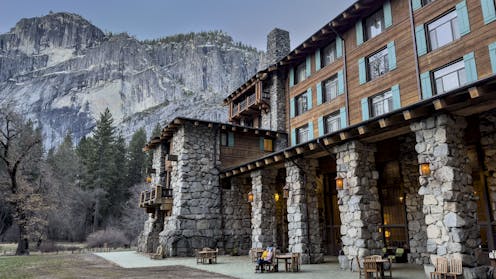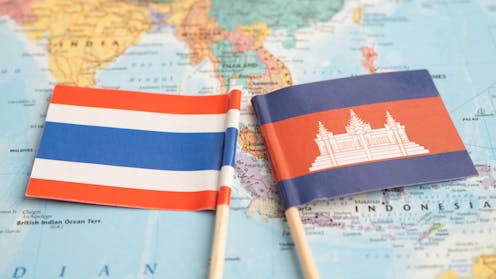Yosemite embodies the long war over US national park privatization
- Written by Michael Childers, Associate Professor of History, Colorado State University

The Trump administration’s cuts to the National Park Service’s budget[1] and staffing have raised concerns among park advocates and the public[2] that the administration is aiming to further privatize the national parks.
The nation has a long history of similar efforts, including a wildly unpopular 1980 attempt by Reagan administration Interior Secretary James Watt to promote development and expand private concessions[3] in the parks. But debate over using public national park land for private profit dates back more than a century before that.
As I explain in my forthcoming book[4], no park has played a more central role in that debate than Yosemite, in California.
Early concerns
In early 1864, Central American Steamship Transit Company representative Israel Ward Raymond wrote a letter to John Conness, a U.S. senator from California, urging the government to move swiftly[5] to preserve the Yosemite Valley and the Mariposa Grove of giant sequoia trees to prevent them from falling into private hands. Five months later, President Abraham Lincoln signed the Yosemite Grant Act, ceding the valley and the grove to the state of California, “upon the express conditions that the premises shall be held for public use, resort, and recreation[6].” This was years before Yellowstone became the first federal land designated a national park[7] in 1872.
Controversy arose quickly at Yosemite. Two men – James Lamon and James Hutchings – had claimed land in the valley[9] before the federal government gave it to California. Both began commercial operations, Lamon growing cash crops[10] and Hutchings operating a hotel[11].
California said their businesses threatened the state’s ability to develop roads and trails in Yosemite by competing for tourist dollars. A legal battle ensued and was not resolved until an 1872 U.S. Supreme Court ruling[12] found that the men’s land claims had not been fully validated according to the procedures of the time. The California legislature paid both men compensation for their land[13], and both left the park.
In 1890, neighboring parts of the Yosemite area[14] became America’s third national park – and in 1906, the federal government again took possession of the Yosemite Valley itself and the Mariposa Grove, specifically to incorporate them into an expansion of the national park[15].
Development rights
Yet, as my research has found, the role of private interests in the park remained unsolved. Private companies under contract to the National Park Service have long provided needed amenities such as lodging and food[16] within the national parks. But questions over what is acceptable in national parks in the pursuit of profit have shaped Yosemite’s history for generations.
In 1925, I found, the question centered on the right to build the first gas station inside the park, in Yosemite Valley. Two private businesses, the Curry Camping Company and the Yosemite National Park Company, had long competed for tourist dollars within the park. Each wanted to build a gas station to boost profits.
Frustrated over the need to decide[17], National Park Service Director Horace Albright ordered the rival firms to simplify management of the park’s concessions. The companies merged, and the newly formed Yosemite Park and Curry Company was granted the exclusive rights to run lodges, restaurants and other facilities within the park, including the new gas station.
But as I found in my research, the park service and the concessions company did not always see eye to eye on the purpose of the park. The conflict between profit and preservation is perhaps most clearly illustrated by the construction of a ski area within the park in the early 1930s. The park service initially opposed the development of Badger Pass Ski Area as not conducive to the national park ideal[18], but the Yosemite Park and Curry Company insisted it was key to boosting winter use of the park.
In 1973, the Music Corporation of America, an entertainment conglomerate, bought the Yosemite Park and Curry Company. The company already had a tourist attraction operating near Hollywood, where visitors could pay to tour movie sets[19], but had not yet changed its name to Universal Studios or launched major theme parks in Florida and California. Its purchase of the park’s concessions set off a firestorm of controversy[20] over fears of turning Yosemite into a theme park.
That didn’t happen, but annual park visitor numbers climbed from 2.5 million to 3.8 million[21] over the 20 years MCA ran the concessions, which sparked concerns about development and overcrowding in the park. Conservationists argued the park service had allowed the corporate giant to promote and develop the park in ways that threatened the very aspects of the park most people came to enjoy[22].
With three restaurants, two service stations with a total of 15 gas pumps, two cafeterias, two grocery stores, seven souvenir shops, a delicatessen, a bank, a skating rink, three swimming pools, a golf course, two tennis courts, kennels, a barbershop, a beauty shop, Badger Pass Ski Area and three lodges, the Yosemite Valley was a busy commercial district[23]. Critics argued that such development contradicted the park service’s mandate to leave national parks unimpaired for the enjoyment of future generations[24].
Who owns the names?
Falling profits and consolidation within the music industry led MCA to sell its concessions rights in Yosemite in 1993. The Delaware North Companies, a global hospitality corporation, took over and ran the park’s concessions[26] until 2016, when it sold the rights to Aramark.
But in that sale, the question of public resources and private profits arose again. Delaware North demanded $51 million in compensation[27] for Aramark continuing to use the names of several historic properties within the park, such as the Ahwahnee, a hotel[28], and Curry Village[29], another group of visitor accommodations. The company claimed those names were a part of its assets under its contract with the park service.
The park service rejected the claim, saying the names, which dated back more than a century, belonged to the American people. But to avoid legal problems during the transition, the agency temporarily renamed several sites[30], including calling the Ahwahnee the Majestic Yosemite Hotel and changing Curry Village to Half Dome Village. Public outrage erupted, denouncing the claim by Delaware North as commercial overreach[31] that threatened to distort Yosemite’s heritage. In 2019, the park service and Aramark agreed to pay Delaware North a total of $12 million[32] to settle the dispute, and the original names were restored.
Protesters unfurl an upside-down U.S. flag from the top of El Capitan in Yosemite National Park in February 2025, protesting Trump administration changes to the National Park Service.Renewed interest in commercial efforts
In June 2025, Yosemite again took center stage in the dispute over the role of federal funding versus private interests at the start of the second Trump administration when a group of climbers unfurled an American flag upside down off El Capitan[33] in protest of the administration’s cuts in personnel and slashing of the park service’s budget.
Conservationists, including former National Park Service Director Jonathan Jarvis, argued that by defunding the park service[34] and laying off as much as a quarter of its workforce[35], the Trump administration was “laying the groundwork to privatize” the national parks[36] by allowing corporate interests more access to public lands[37]. Those concerns echo ones raised during the first Trump administration, when the White House argued privatization would better serve the American public[38] by improving visitor experiences and saving federal dollars.
Whichever side prevails in the short term, the debate over the role of private interests within national parks like Yosemite will undoubtedly continue.
References
- ^ cuts to the National Park Service’s budget (www.deseret.com)
- ^ concerns among park advocates and the public (www.theguardian.com)
- ^ promote development and expand private concessions (www.nps.gov)
- ^ my forthcoming book (www.nebraskapress.unl.edu)
- ^ urging the government to move swiftly (www.nps.gov)
- ^ held for public use, resort, and recreation (www.loc.gov)
- ^ first federal land designated a national park (www.archives.gov)
- ^ Sepia Times/Universal Images Group via Getty Images (www.gettyimages.com)
- ^ claimed land in the valley (www.nps.gov)
- ^ Lamon growing cash crops (home.nps.gov)
- ^ Hutchings operating a hotel (www.nps.gov)
- ^ 1872 U.S. Supreme Court ruling (supreme.justia.com)
- ^ paid both men compensation for their land (home.nps.gov)
- ^ neighboring parts of the Yosemite area (www.nps.gov)
- ^ incorporate them into an expansion of the national park (www.nps.gov)
- ^ such as lodging and food (www.nps.gov)
- ^ Frustrated over the need to decide (npshistory.com)
- ^ not conducive to the national park ideal (www.jstor.org)
- ^ pay to tour movie sets (www.latimes.com)
- ^ firestorm of controversy (www.sierraclub.org)
- ^ from 2.5 million to 3.8 million (irma.nps.gov)
- ^ aspects of the park most people came to enjoy (www.jstor.org)
- ^ busy commercial district (www.jstor.org)
- ^ unimpaired for the enjoyment of future generations (www.nps.gov)
- ^ David McNew/AFP via Getty Images (www.gettyimages.com)
- ^ ran the park’s concessions (www.kvpr.org)
- ^ demanded $51 million in compensation (niagarafallsreporter.com)
- ^ Ahwahnee, a hotel (www.nps.gov)
- ^ Curry Village (www.nps.gov)
- ^ agency temporarily renamed several sites (www.nps.gov)
- ^ commercial overreach (boomcalifornia.org)
- ^ total of $12 million (www.npr.org)
- ^ American flag upside down off El Capitan (www.cpr.org)
- ^ defunding the park service (www.usatoday.com)
- ^ quarter of its workforce (www.nytimes.com)
- ^ laying the groundwork to privatize” the national parks (www.theguardian.com)
- ^ corporate interests more access to public lands (grist.org)
- ^ privatization would better serve the American public (perma.cc)
Authors: Michael Childers, Associate Professor of History, Colorado State University




